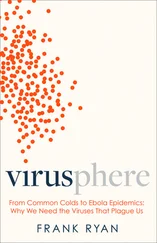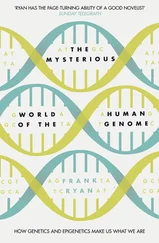I pressed him a little further: ‘I’m aware also that certain herpes viruses appear to be particularly venomous when they cross species in monkeys. Is it your opinion that we are seeing the same thing?’
‘Oh, absolutely! I think that some of the most dramatic examples in primates are viruses like Herpesvirus simiri and anteles . They have co-evolved in one species of monkey, like spider or squirrel monkey, and when you put them into contact with any other species of monkey they are highly, highly lethal, but in the resident co-evolving species they do nothing.’
‘Would you agree that, here again, we’re looking at an example of an evolutionary role?’
‘My guess is you could even find evidence that the monkeys that are most susceptible occupy the same ecological niche and are eating the same food, as opposed to some of the ones, even if they cover the same territory, that eat a different food and fit a different living niche, and that are not quite as susceptible [to the virus].’
When two or more partners enter into a mutualistic symbiosis, each partner will contribute an innate ability, or trait, that the other partner lacks. It is obvious what a host contributes to a virus-host partnership, since it offers the virus shelter and the use of the host’s own genetic machinery to make more copies of itself. Without the host, the virus would not survive. But although it might appear less obvious, there is in fact a key ability that the virus possesses – in evolutionary terms, a “trait” – that the host does not. This is the innate potential for lethal aggression. In the example of Elysia chlorotica , we witnessed how the retroviruses that are long-established partners within its nucleus and tissues, may end the slug’s life cycle with what appears to be a ferocious demonstration of aggression. In fact, following my researches into viral behaviour, in Virus X , I first put forward the evolutionary concept of “aggressive symbiosis” as an important mechanism – I have never claimed it to be an exclusive one – in a number of situations in nature, and in particular in the interaction between plague viruses and their hosts. But coining the mechanism was merely the first step in the hypothesis I was attempting to formulate. I now had to figure out how such a mechanism might work, in evolutionary terms, as part of the evolving partnerships of viruses and their hosts in nature.
I began by making a couple of reasonable assumptions. Up to this time, virtually all evolutionary research within the discipline of virology had been Darwinian in concept. I was familiar with its conclusions, which were central to medical virology, and, by and large, I agreed with them. I also took the view that Darwinism and symbiogenesis were not mutually exclusive. There was overwhelming evidence that both mechanisms operated in nature. This suggested that each virus-host relationship needed to be examined in its own right: but it also needed to be examined through the binocular vision of both evolutionary mechanisms, and not merely through one. Sometimes the dominant mechanism would fit the Darwinian paradigm, such as the operation of selection at selfish individual, or selfish gene, level. Sometimes the dominant mechanism would more closely fit the symbiotic paradigm, with selection operating to an important degree at the level of the partnership of virus and host. Indeed, I saw no reason why, in certain situations, both paradigms would not apply, with a dynamic that might start with dominance at selfish level, but might evolve to end up with a dominant effect at partnership level. This would fit with the original thinking of de Bary. Moreover, it would also fit with the mathematical derivations of two Oxford-based Professors, Anderson and May, who, in the early 1990s, had spent a lot of time examining virus-host dynamics, including co-evolution – a Darwinian concept that came very close to the symbiotic concept of partnership.
Over the ensuing years, I continued to work on the dynamic of emerging plague viruses, and I discovered that aggressive symbiosis worked through a series of very specific steps. It began when the virus invaded a new, or virgin, host. The interaction could result in a variety of different behaviours, depending on whether the virus came from a closely related species, and was thus pre-evolved in its infectious strategies, or whether it came from a more distantly related species, when its infectious strategies would not be so efficiently pre-evolved. The Sin Nombre hantavirus came from a rodent and, though it killed a high percentage of the people it infected, it could not efficiently transmit between people. Several recently notorious viruses Marburg, Ebola, Lassa fever and the South American haemorrhagic fever viruses, such as Machupo and Junin, did exactly the same. Lassa, Machupo and Junin all came from rodents and were not sufficiently transmissible between people. While the hosts of Marburg and Ebola were still uncertain, their failure to transmit efficiently between people suggested a distantly related host. In such cases, the genetic differences been former and new host ensured that the evolutionary dynamic ended there. But where a virus came from a closely related species, such as the rabbit myxomatosis virus, which was symbiotic with the Brazilian wood rabbit, or, as with HTLV and HIV, when it hopped species from monkeys and chimpanzees to the closely related humans, the genetic similarities paved the way for a new evolutionary dynamic. Since the tissue and immune barriers of the original hosts were very similar to those of the new host, these viruses would possess pre-evolved strategies that would work pretty much in the new host as they did in the old. Moreover, all of these viruses had a very important characteristic in common. Once they entered an individual, or species, they never went away, not in terms of the individual, and not in terms of the entire affected population, or even the species. The biological term for such a relationship is “persistence” and the viruses are said to be “persistent viruses”. The very nature of such a long-term, and inevitably intimate, relationship has major implications for the virus-host evolutionary dynamics.
For a virus to enter into such a persistent relationship with a host, it is obvious that the host must be able to survive the long-term presence of the virus. In some cases, this may not necessarily lead to any major manifestations of disease. It is possible, I would even venture likely, that many viruses in nature enter into benign partnerships without the manifestations of what we recognise as a plague – but such interactions, by their very nature, are likely to pass unnoticed. But with myxomatosis, as with HIV, the virgin host, whether Australian rabbit or global human population, cannot live in a benign harmony with the newly arrived virus. A variable proportion, 99.8% of the Australian rabbits, and perhaps as many as 98% of the human species, cannot survive the initial contact with the myxomatosis virus and HIV-1 respectively. Here the first step of aggressive symbiosis kicks in. The invading virus kills all those who cannot live with its presence. I labelled this brutal dynamic “plague culling”. This is what we saw with myxomatosis, and I’m afraid it is what we would likely have seen with AIDS had it arrived among our human, or pre-human, ancestors when they inhabited the geographically contiguous area of the hinterlands of the African rainforest. We can anticipate that plague culling would reduce the new host population to a rudiment, selected by the lethality of the virus, and genetically distinct from the majority of its former population, or species. Although the survivors might be sickly, or have their lives somewhat shortened, the key implication, from the evolutionary perspective, is that they are capable of living with the persisting presence of the virus. The second step of aggressive symbiosis involves long-term co-evolution of virus and host – with the potential of mutualistic partnership.
Читать дальше












